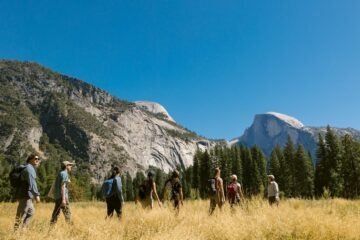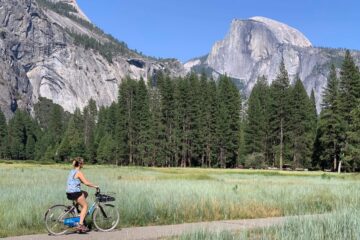Above: PSAR volunteers patrolling near Mt. Dana. Photo: Keith Walklet.
Picture this: A family is out for a late summer hike in the Tuolumne Meadows area. Dusk is falling. They think they’re heading back toward the trailhead. They’re not. Fortunately, they encounter a friendly face in a yellow shirt, who points them in the right direction. Instead of finding themselves lost on a cold, dark night in Yosemite’s high country, the family ends up back where they started, safe and sound.
And with that, we bring you … nine things to know about PSAR!
1. What PSAR stands for.
We’re pretty confident that most of you have never heard of PSAR — or if you have, you’ve stored it away in your mental file for obscure acronyms. Let’s clear that up: PSAR (pronounced pee-sar) stands for Preventive Search and Rescue.
In Yosemite, the PSAR and SAR (Search and Rescue) programs work toward a shared goal 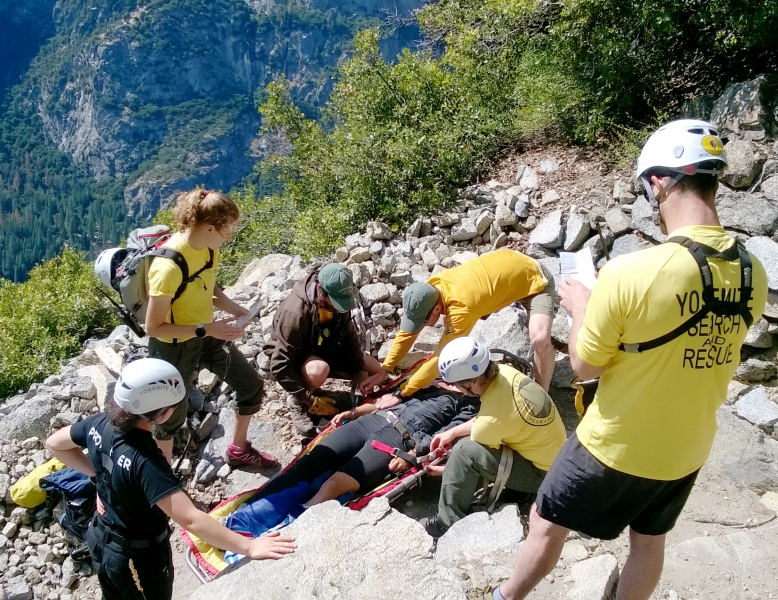 (keeping people safe), but fill different niches. PSAR is proactive; SAR is reactive. PSAR aims to prevent incidents; SAR responds when incidents occur. PSAR achieves its goal through trail patrols, educational signs, audio messages played on shuttle buses, and one-on-one interactions with visitors to preempt or change risky behaviors. Ideally, effective PSAR activities mean less work for the SAR team.
(keeping people safe), but fill different niches. PSAR is proactive; SAR is reactive. PSAR aims to prevent incidents; SAR responds when incidents occur. PSAR achieves its goal through trail patrols, educational signs, audio messages played on shuttle buses, and one-on-one interactions with visitors to preempt or change risky behaviors. Ideally, effective PSAR activities mean less work for the SAR team.
The PSAR program interacts with thousands of visitors each year, encouraging people to set realistic hiking goals, stay hydrated, or move back from swift water. And it seems to be working: In recent years, emergency response activity in the park has declined. In 2009, there were 7.2 SAR missions per 100,000 visitors; in 2015, that number was down to 5.53.
2. PSAR is an all-volunteer program.
With one notable exception (we’ll get to that), Yosemite’s PSAR program is a volunteer operation. Some people donate their time for a few weeks or months before returning to school or work; others are in the park year-round. In the summer, the roster can include as many as 60 or 70 volunteers, representing a wide range of ages and physical abilities. Whether they spend their time patrolling strenuous trails (like the pair pictured above, on their way down from Mt. Dana), sharing tips at trailheads, or biking around the Valley to catch visitors at popular spots, all PSAR volunteers share at least two traits: Good communication skills, and a passion for ensuring the safety of Yosemite visitors.
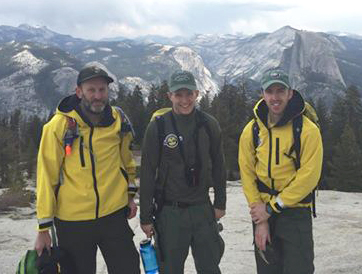 The exception to the all-volunteer set-up is Alan Hageman, the PSAR supervisor. Alan has been involved in public safety throughout his adult life, from joining the Coast Guard at age 18 to supporting emergency services and education at National Park Service sites from Death Valley to Virginia. In the spring of 2015, he took the helm of Yosemite’s PSAR program. [Fun fact: For a few months each year, you can catch Alan on stage at the Yosemite Theater, where he is helps lead a special Search and Rescue presentation. The show wrapped up this week, but fortunately Alan agreed to share some of his stories and tips for this blog!]
The exception to the all-volunteer set-up is Alan Hageman, the PSAR supervisor. Alan has been involved in public safety throughout his adult life, from joining the Coast Guard at age 18 to supporting emergency services and education at National Park Service sites from Death Valley to Virginia. In the spring of 2015, he took the helm of Yosemite’s PSAR program. [Fun fact: For a few months each year, you can catch Alan on stage at the Yosemite Theater, where he is helps lead a special Search and Rescue presentation. The show wrapped up this week, but fortunately Alan agreed to share some of his stories and tips for this blog!]
3. Safety is timeless; PSAR is (relatively) new.
YOSAR got its start back in the 1960s, when big wall climbing was becoming more popular, but the PSAR program is much younger. The park started formalizing Preventive Search and Rescue in 2007, and the expanded volunteer program launched in 2013. By July of 2013, injuries on the Mist Trail, notorious for having the highest injury frequency in the entire park, were down by 45 percent.
4. A little planning goes a long way.
Many of the problems that Alan and his volunteers witness — and work hard to prevent —come down to a lack of planning. Hikers might do enough preparation to set their sights on a goal (reaching the top of Yosemite Falls, for example), but then underestimate the effort and time it will take to reach a destination and get back safely. Asking key questions and bringing essentials such as water, snacks, and a headlamp can help prevent common issues such as dehydration or fatigue-related injuries. See #9 for full list of prep tips!
5. Shallow does not mean safe.
The majority of injuries that occur on trails, while sometimes painful, are rarely life-threatening. Most serious incidents happen when people leave trails — and water is the top cause of accidental death in the park. Alan notes that water-related injuries and deaths often start in shallow water, where a simple slip can result in being swept into a swift current or over a waterfall.
6. Hiking practice can happen anywhere.
Climbing uphill often seems like the hardest part of a hike, but going down can be even more challenging! Most hiker injuries in our mountainous park occur when people are hiking down trails. That said, ascending a steep trail, whether you’re gaining 400 or 4,000 feet, is not something to take lightly.
Alan’s recommendation: Prepare for your hike by opting for stairs in your daily routine. Practice in stores, at the office or in your apartment building. Carry a full pack to see how that added weight affects your muscles, joints and breathing as you climb and descend. Take note of how you feel, and remember that depending on the trail, hiking in Yosemite can equate to going up and down hundreds of flights of uneven stairs (while also dealing with the effects of altitude and unpredictable weather).
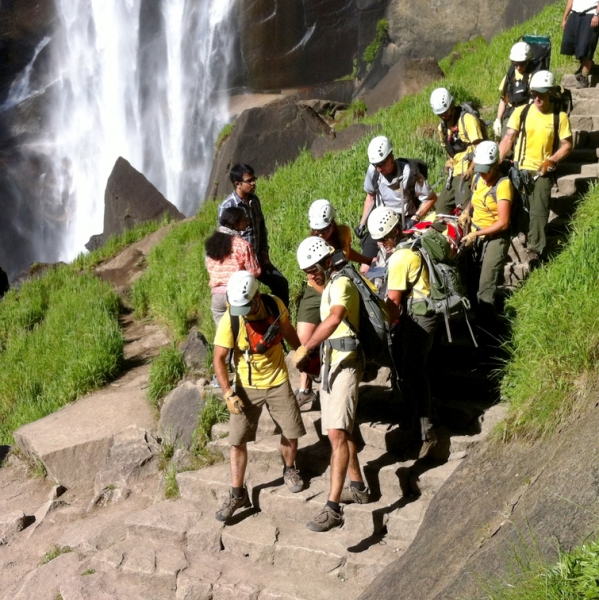
7. Seasonal shifts = seasonal risks.
For most of us, new seasons in Yosemite call to mind new scenery: Gushing spring waterfalls, bright summer wildflowers, golden autumn leaves, snow-capped winter peaks. For Alan and his team, new seasons bring new challenges. Spring means fast-moving water as snowmelt fuels falls and rivers. Summer means hot weather and an influx of visitors. Fall and winter mean limited daylight, cold temperatures and increased precipitation. One easy way to help the PSAR team: Know the potential season-specific risks before you go to the park!
8. PSAR protects more than visitors.
The biggest part of a PSAR volunteer’s job is keeping people safe. They work hard to identify and address unsafe behaviors, by suggesting alternative ways for visitors to enjoy the park; handing out supplies to unprepared hikers; and more. But beyond their official PSAR duties, the volunteers help protect the park. By keeping people on trails, they help preserve sensitive habitat. Alan also encourages his crew to serve as active park stewards, by picking up litter on trails or restoring wilderness campsites and fire rings; to educate visitors about proper food storage, wildlife interactions and fire prevention; and to keep an eye out for resource damage.
9. Anyone can be part of PSAR.
This is true even if you don’t have time to be an official PSAR volunteer. You can help make the park an even safer place by making sure that you are prepared for your trip, and by encouraging your friends and family to do the same. Use this handy check-list to plan your next Yosemite adventure!
PREPARATION CHECKLIST |
| □ What’s the goal of my hike? What do I want to see and do? |
| □ Once I’m in the park, how do I get to the trailhead or parking area? |
| □ How many miles will I be hiking, including the return trip, and what is the total elevation change? |
| □ What altitude will I reach? Do I need to add in some time to acclimate? Yosemite Valley is at 4,000 feet, which is high enough to make even healthy people feel more tired than usual. Altitude sickness can begin at 6,500 feet, well below many of the park’s popular destinations. |
| □ What’s the weather forecast? |
| □ Do I have the right supplies? Be sure to bring essentials such as a map and compass, first aid kit, sunscreen, warm layers, broken-in footwear, a flashlight or headlamp, and adequate water and food. Alan recommends a quart or liter of water for every 2-3 hours of physical activity, and easily digestible salty snacks to replenish what you lose through sweat. |
| □ Back to the beginning: What is my goal? Based on the mileage, altitude, elevation change and weather, is it still realistic? If not, pick a new adventure! There are plenty of destinations and experiences to explore in Yosemite.
Once you’re set on a plan, share your itinerary, along with a description of your vehicle, your route, and your expected return date, with a friend or family member. The more information you leave behind, the easier it will be for the SAR crew to help you if something goes wrong. |
Making sure you’re prepared before you hit the trail is a great way to help promote safety in Yosemite. Here’s another one: Become a Conservancy donor! By supporting the park’s PSAR program, your gifts help ensure that Alan and his volunteers can continue working to protect visitors (and natural resources) in every season.
* If you’re interested in applying to be a PSAR volunteer, email yose_psar@nps.gov for more information.


